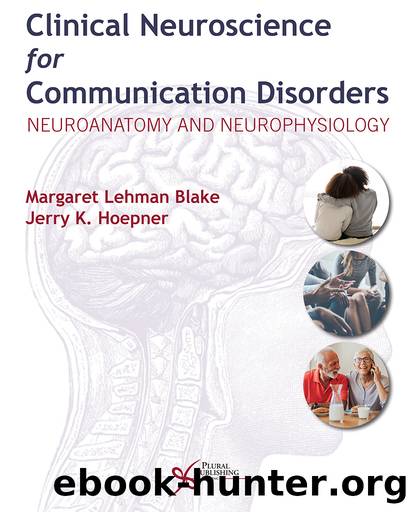Clinical Neuroscience for Communication Disorders: Neuroanatomy and Neurophysiology by Margaret Lehman Blake;Jerry K. Hoepner;

Author:Margaret Lehman Blake;Jerry K. Hoepner;
Language: eng
Format: epub
Publisher: Plural Publishing Inc.
Published: 2021-02-15T00:00:00+00:00
FIGURE 11â7. Branches of the facial nerve. Yellow, special visceral efferent (muscles of facial expression); red, general visceral efferent (glands); green, special visceral afferent (taste); blue, general somatic afferent (external ear canal).
The SVE component of the facial nerve innervates muscles of facial expression, including the orbicularis oris that forms the lips, all of the muscles that elevate or depress the lips and the corners of the mouth, the orbicularis oculi around the eyes, and the frontalis muscle that elevates the eyebrows. The stapedius muscle in the middle ear also is innervated by CN VII. As with the GVE fibers, the UMN axons extend down to the pons, and most cross over before synapsing in the facial motor nucleus. The innervation of facial muscles is not strictly contralateral. The upper face including around the eyes and the frontalis muscle on the forehead receive bilateral innervation. Some UMNs targeting the upper face cross over in the pons and synapse contralaterally, whereas others remain ipsilateral. This provides bilateral innervation to the muscles in the upper face. LMNs to the lower face receive only contralateral innervation (Figure 11â8). This mixture of bilateral and unilateral innervation leads to specific patterns of weakness that aid in diagnosing the level of damage, as discussed later.
Several reflexes are mediated by the facial nerve, including the corneal, sucking, and stapedial reflex. The first two involve sensory signals carried through CN V (from the cornea and the lips, respectively), with synapses onto LMNs in the facial nuclei. The stapedial reflex is triggered by loud sounds that are carried through CN VIII to the LMNs of the facial nucleus to contract the stapedius muscle, which retracts the stapes from the oval window and limits the movement of the ossicles to protect the cochlea.
Unilateral UMN damage will result in contralateral lower facial weakness, with spared movement of the upper face (forehead). Essentially, the person will not be able to elevate/retract the lips on the contralateral side when asked to smile (lower face weakness) but will be able to raise both eyebrows (preserved upper face movement). This pattern is due to the bilateral innervation of the upper face: When UMNs from one side of the brain are damaged, the upper face still receives ipsilateral innervation (Figure 11â9). If damage occurs to the facial nerve unilaterally, the person will exhibit weakness or paralysis to the entire ipsilateral face: They will not be able to elevate their lips in a smile or raise their eyebrow on the affected side. This is because the damage is to the LMN to the ipsilateral muscles of both the upper and lower face. Because of the clinical relevance of these movements, they are a common component of an oral mechanism exam (OME), as described later in this chapter.
Download
This site does not store any files on its server. We only index and link to content provided by other sites. Please contact the content providers to delete copyright contents if any and email us, we'll remove relevant links or contents immediately.
Application of a Novel Technique for Clinical Evaluation of Nitric Oxide-Induced Free Radical Reactions in ICU Patients by Unknown(693)
Rosenâs Emergency Medicine Concepts and Clinical Practice by Ron Walls; Robert Hockberger; Marianne Gausche-Hill; Timothy B. Erickson; Susan R. Wilcox(571)
Oxidative damage to surfactant protein D in pulmonary diseases by Vitality Starosta1 & Matthias Griese1†(406)
Social Science Perspectives on Global Public Health by Vincent La Placa & Julia Morgan(372)
Constructing Canine Consent; Conceptualising and Adopting a Consent-focused Relationship with Dogs by ERIN JONES(329)
Organic Chemistry: An Acid - Base Approach by MICHAEL SMITH(299)
ADVANCED EMERGENCY CARE AND TRANSPORTATION OF THE SICK AND INJURED by Unknown(270)
Saunders Nursing Drug Handbook 2024 - E-Book by Unknown(262)
Davis's Comprehensive Manual of Laboratory and Diagnostic Tests with Nursing Implications by Unknown(245)
Diagnostic and Statistical Manual of Mental Disorders, Fifth Edition, Text Revision (DSM-5-TR(tm)) by Unknown(245)
Socio-Life Science and the COVID-19 Outbreak : Public Health and Public Policy by Makoto Yano; Fumihiko Matsuda; Anavaj Sakuntabhai; Shigeru Hirota(244)
Human Microanatomy; Cell Tissue and Organ Histology with Celebrity Medical Histories by Stephen A. Stricker(242)
Berne and Levy Physiology E-Book by Unknown(234)
Replacing the Dead by Mie Nakachi;(229)
Handbook of Skin Disease Management by Jiyad Zainab;Flohr Carsten; & Carsten Flohr(228)
Access to Medicines and Vaccines in the South : Coherence of Rules and Policies Applied by the European Union Commission by Stephen Kingah(224)
The Pocket Guide to Sensorimotor Psychotherapy in Context (Norton Series on Interpersonal Neurobiology) by Pat Ogden(218)
Deep Learning and Medical Applications by Unknown(217)
Advances and Technical Standards in Neurosurgery by Unknown(213)
